| [Exercise] John C. G. Sturdy |
![[John's home]](../home.png) Last modified: Sun Jun 10 22:09:51 GMT Daylight Time 2007
Last modified: Sun Jun 10 22:09:51 GMT Daylight Time 2007
|
![[Recumbent]](recumbent-f3q.jpg)
I used to cycle a lot, mostly on a fixed-wheel bike, then bought a car, and got out of practice at cycling, and became relatively unfit, which was probably the main cause of my repetitive strain injury. One effect of that was that I became uncomfortable with conventional handlebars; however, the specialist said that getting fit was the main key to overcoming my RSI. (Actually, I'd wanted one ever since I saw a picture and description in the original Richard's Bicycle Book, about 20 years earlier.)
So I bought myself a recumbent trike, and am very pleased with it. It is much more comfortable than an upright cycle!
My recumbent is an Optima Rider. It's pretty solid, in both senses: mostly reliable, but heavy. I added the front mudguards fairly soon after getting it; I live in a dairy-farming area, and was getting quite spattered where my regular route crosses that of a herd of cows.
The main exceptions to its reliability have been the hydraulic front brakes (I have now replaced the hydraulic part of the system with conventional brake cables) and the chain roller mechanism, which has now been replaced by one made by ICE for use on their Trice range.
The non-standard additions to it that I have done so far are:
More recently, I added a fairing, which eventually broke, and I've now replaced it with a redesigned one.
I got some Radical Designs panniers, and also a small Carradice saddle pack (visible in the picture at the front end of the main panniers), mostly to provide a pocket further forward than the panniers, so I could keep my phone in reach. Just forward of the saddle pack is an Eco-blast air horn. I now also have a trailer, as I think I was overloading the panniers.
I have also made a carrier for getting the trike onto my Land-Rover roof-rack.
People tend to assume that, being low, the recumbent will be hard for motorists to see. This doesn't seem to be the case; its unusualness catches the eye far more than an upright cycle does, and it's much harder to dismiss as ``just a bike''. In fact, lots of drivers around where I live seem to lack the confidence to pass it, and I have to wave them past, or just pull in to the side. (Driving licences are effectively optional in Eire; unaccompanied learners are either allowed or tolerated, I'm still not sure quite which it is.)
The fairing is made from polycarbonate and aluminium.
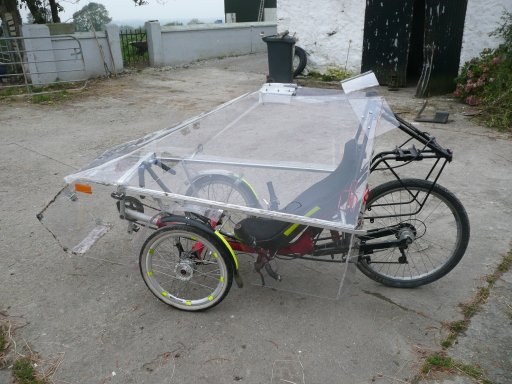
I made the fairing to protect me from the Irish rain, rather than for streamlining. (It's also turned out to be useful against dogs.) It's made of polycarbonate and aluminium, with the polycarbonate crudely thermoformed with a mini-blowtorch, and the aluminium bolted and riveted.
It is mounted at the rear by being hinged onto an aluminium frame (approximately an A-frame with extra struts going to the back of the carrier) bolted to the carrier bolts and clipped to the back of the carrier, and at the front tubular legs at the bottom of the stiffening strips fit into wider tubes bolted and glued to Stauff clamps that fit round the crossmember.
The design of the rear frame lets me post the panniers (permanently paired) through the large roughly triangular gap, and then clip the lighting unit into place through the rectangular gap.
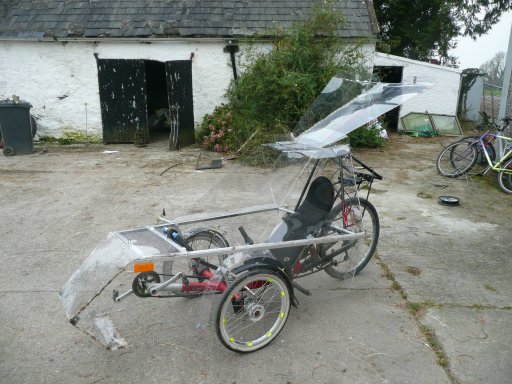
Whereas the first version lifted up in its entirety (which proved cumbersome in practice), the current one has a hatch that lifts up for getting in and out.
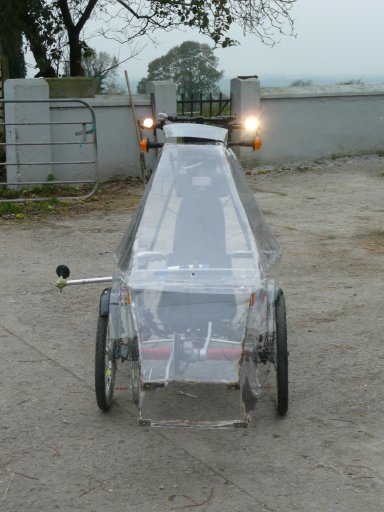
The lighting box, mounted on the rack behind me, lets the front lights shine forward over the fairing.
Since the fairing makes it harder to stick my hand out for turn signals, I have made electric turn signals as part of the lighting box. I'm thinking of adding a flashing "Please pass" sign, as drivers often sit on my tail, unsure about passing, and I'm not sure that they understand attempts to wave them past. (Perhaps they confuse them with ``turning right'' or ``turning left'' signals?)
I'm still adjusting the fairing; so far it seems to work OK, although there are still squeaks, rattles and various other minor awkwardnesses. But it's great to be able to cycle in the rain without getting significantly wet.
I've built a new fairing for this winter season, with some changes from the old one as follows:
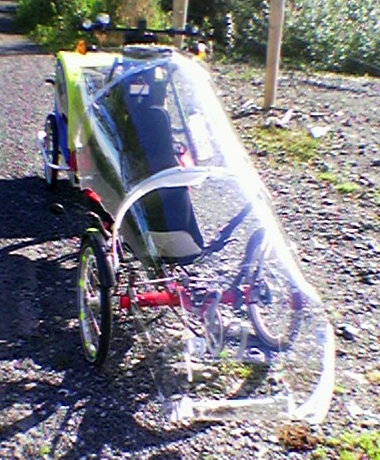
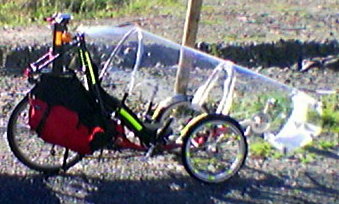
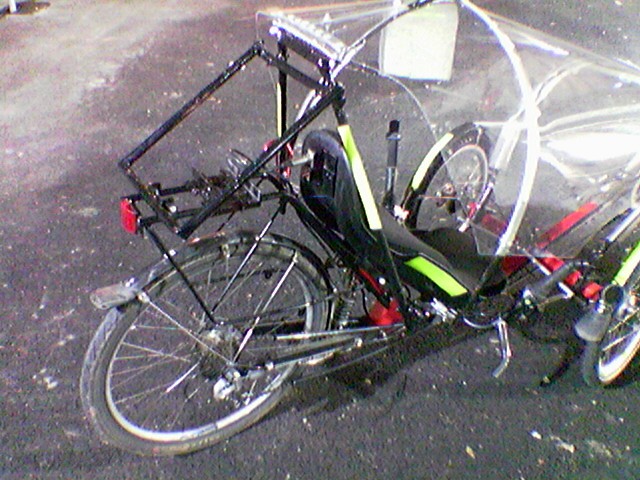
The old fairing was made from 2mm polycarbonate sheet, stiffened slightly by two pairs of aluminium strips rivetted to it, one strip of each pair on the inside and one on the outside.
It lifted at the front, allowing me to get on and off the recumbent pretty much as normal.
![[View forward]](trike-view-forward.jpg)
As I suspected I might, I found that rain didn't run off very well, and there was a lot of condensation inside, so I made a horizontal slit at eye level (not visible in the main photos -- I made the slit later), so I can see clearly at least straight ahead, no matter how many raindrops accumulate; this should be more reliable than adding a wiper, and take less attention, and also gives some airflow, which is definitely appreciated. Just below this is a bulldog clip for holding language notes, to give me something to think about on the journeys! If going somewhere unfamiliar, the clip could be useful for maps or directions.
I also added a stiffer internal frame than shown in the photos, so it will flex less as I open and close it. The internal frame also gives me somewhere more convenient for the GPS, and phone; and makes a slightly easier handle for raising and lowering the canopy from the inside.
On 2006-11-13, a German Shepherd Dog, that lives on the same lane as me, made a sustained and vicious attack on me as I cycled past. He charged at me, hitting the fairing, ramming me a couple of times, then grabbed the panniers and tried to drag me to a halt at least three times. Fortunately I was in a low gear and could keep going. It was a really determined attack, and I reckon if I hadn't had the fairing, or had been on an upright or on foot, he probably would have killed me. As it was, with the fairing, he couldn't actually reach me (although I've added some more protection to close off the back of it a bit better). After the attack, I found I had a flat tyre, although I'm not sure that was the dog -- there was also a thorn, so perhaps the animal and plant kingdoms were conspiring against me!
I've contact the dog-owner, who says he'll keep him chained, and the Gardaí (police), who will have a further word with him. But the dog's been loose at least one more time since, and I'm now considering weaving barbed wire between the spokes of the wheels, and putting some strands of it around the panniers and the edges of the fairing, for further protection. A further possibility is to electrify the wire, alternating positive and negative strands. Not pleasant, but then neither are dogs that attack cyclists.
| [Exercise] John C. G. Sturdy |
![[John's home]](../home.png) Last modified: Sun Jun 10 22:09:51 GMT Daylight Time 2007
Last modified: Sun Jun 10 22:09:51 GMT Daylight Time 2007
|